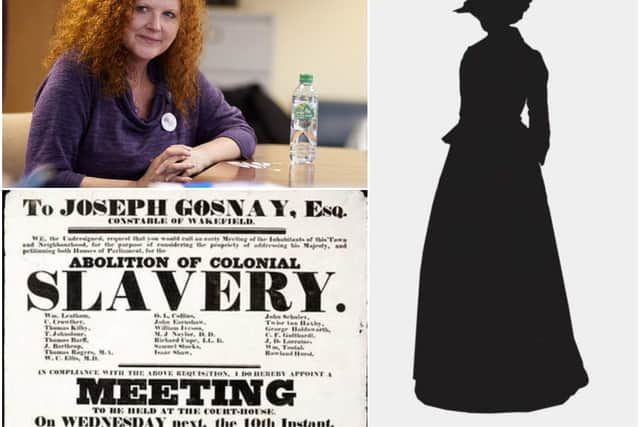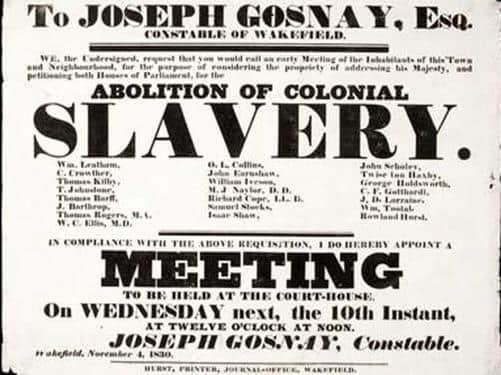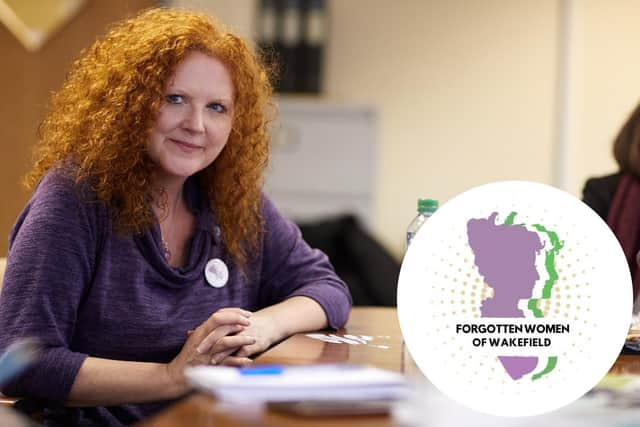Forgotten Women of Wakefield: Historic newspaper editor Ann Hurst who led slave abolition movement in Wakefield to be honoured with a blue plaque
and live on Freeview channel 276
Ann Hurst took over The Wakefield and Halifax Journal following her husband’s death in 1823.
Although new to the newspaper industry, she had served at the heart of her community for many years, with experience as a bookseller, stationer, patent medicine vender and tea dealer.
Advertisement
Hide AdAdvertisement
Hide AdShe used her newspaper as a platform to call for radical change, issuing propaganda calling for the abolition of slavery and suffrage for women, and later went on to help found Wakefield's first hospital for the poor.


Her work has been directly linked to the election of Daniel Gaskell, the city's first liberal MP, whose political platform included calling for the abolition of slavery and reform of the Church.
Ann’s story has been uncovered as part of the Forgotten Women of Wakefield project, a volunteer-run group who are seeking to increase the number of blue plaques in the city dedicated to women to be equal to those dedicated to men, with the support of the Express.
Sarah Cobham, founder of Dream Time Creative, the company behind the FWW project, said: “Ann was a busy woman. She used her printing press for good and nailed her colours to the mast publicly.
Advertisement
Hide AdAdvertisement
Hide Ad"She was really well established in Westgate. Ann was seeding revolution from the centre of Wakefield, so when hr husband died in 1823 and she got control of the printing press she set up several sister papers.


"She was known for being radical and liberal. She wasn't frightened to lead by example and take people with her.
"The whole idea of this was to elect Daniel Gaskell MP. She influenced the way the voters moved.
"As ever, here at Dream Time Creative we take inspiration from the actions and attitudes of our Forgotten Women and learn from them.
Advertisement
Hide AdAdvertisement
Hide Ad"Ann created history and I am delighted that we are part of the historical and cultural renaissance that is happening as a result of the funding from Historic England and the vision of Wakefield Council at this time."


Despite dedicating her life to furthering radical and liberal causes her whole life, Ann was often overshadowed by her male counterparts.
An 1830 leaflet announcing an Abolition of Colonial Slavery meeting at the Court House lists only men's names, with the only reference to Ann a credit to "Hurst, Printer" at the bottom of the flyer.
It has led to the FWW team, led by researcher Helga Fox, referring to Ann as a "Forgotten Footnote" of Wakefield's history.
Advertisement
Hide AdAdvertisement
Hide AdResearch into Ann’s life was made possible as part of Wakefield Civic Society’s Upper Westgate Heritage Action Zone project, funded by Historic England and Wakefield Council.
Two more blue plaques will also be unveiled in the coming months as part of the Visionary Westgate Women project.
Ann’s blue plaque will be unveiled on Westgate in March for International Women’s Day.
Kevin Trickett, Chair of Wakefield Civic Society, said: “The Society’s partnership with Dream Time Creative on their Forgotten Women of Wakefield project goes from strength and I am delighted to be working with Sarah Cobham and her team of researchers on uncovering the story of Ann Hurst, Wakefield’s first female newspaper proprietor and a ‘mover and shaker’ in Wakefield’s anti-slavery movement.
Advertisement
Hide AdAdvertisement
Hide Ad"This will be the 14th blue plaque we will unveil as part of the partnership created to commemorate the lives of women who have contributed to Wakefield’s social, political, financial and cultural life but whose stories have, until now, often been overlooked and neglected.
“This particular plaque is being delivered as part of our contribution to the Upper Westgate Heritage Action Zone project, funded by Historic England and Wakefield Council, to improve the appearance of both the public realm and some of the buildings in the Upper Westgate Conservation Area.
"As part of the overall project, the Society has been allocated funds to put up some additional blue plaques and to undertake research into the history of the area but we don’t just want to talk about the buildings, we want to learn about the people associated with the street and it’s very satisfying that our first plaque as part of the Heritage Action Zone project is not only to a woman with a strong connection to Westgate but is also one with such an interesting story to tell.”
Wakefield Council, in partnership with Historic England, are co-funding the Wakefield Upper Westgate High Street Heritage Action Zone (HSHAZ) programme, which is providing £3.9million worth of investment into renovating Upper Westgate’s historic buildings, and adjacent yards and ginnels.
The fund will also be used for exciting new cultural events and celebrations such as Visionary Women of Wakefield project.